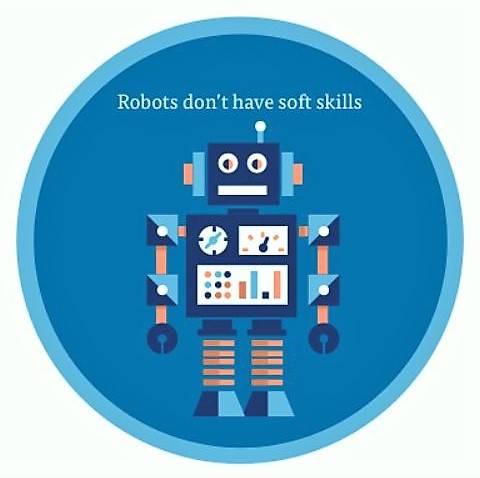If you have noticed changes in your employee’s talents and shortcomings, welcome aboard.
The path to work success is changing. It had long been predicted by the futurists & now the workforce agrees, work training for soft skills is the #1 priority! Talent developers, executives and people managers agree that training for soft skills is the top priority for talent development teams, according to 2018 Workplace Learning LinkedIn report. As technology accelerates, soft skills are in high demand to fuel people and business. 
Training for soft skills is the #1 priority for talent development in 2018.
Talent developers say that training for soft skills is their key focus for 2018. In the age of
automation, adaptability rules. While maintaining technical fluency will be important,
demand for soft skills will continue to accelerate. Industry experts and organizational
partners agree that this should be the top focus for employee development in 2018.
“Soft skills—which are needed to effectively communicate, problem solve, collaborate and organize—are becoming more important for success as the workplace evolves socially and technologically” – SHRM
In 2018 35% of business talent developers expect a budget increase, only 11% expect a decrease, with the majority of their spend allocated to soft skills development programs.
Talent developers are embracing digital transformation. The LinkedIn survey shows that talent developers depend more on online learning solutions than ever before—not only to deliver content, but to measure learning success. They’re watching key industry trends like “microlearning” and “just-in-time learning” in order to better support the modern employee.
Getting employees to make time for learning is the #1 challenge facing talent development in 2018, according to the LinkedIn 2018 Work Learning report. Getting employees to make time for learning has moved up to the #1 challenge facing talent development. This makes sense. If employees are not taking the time to learn, then development programs cannot be successful. The data shows that the #2 challenge facing talent development, “getting managers to take an active role in employee learning”, is a viable solution to overcoming the #1 challenge.
The #1 reason employees say they are not engaging in workplace learning is because they don’t have the time. Executives and people managers agree that getting employees to make time for learning is the #1 challenge for talent development.

If employees can’t find the time to learn, reduce the friction. Meet them on platforms they’re already using with messages that align to their on-the-job needs and professional aspirations. Each group in the survey identified ‘getting employees to make time for learning’ as the #1 challenge facing talent development in 2018. Yet, 94% of employees say that they would stay at a company longer if it invested in their career development. The modern organization needs to meet learners where they already are—aligning development opportunities with employee aspirations and engaging them through the platforms where they are already spending their time.
The # 1 challenge facing talent development in 2018 is getting employees to make time for learning. Getting employees to make time for learning has moved up to the #1 challenge facing talent development. This makes sense. If employees are not taking the time to learn, then L&D programs cannot be successful. Our data shows that the #2 challenge facing talent development, “getting managers to take an active role in employee learning”, is a viable solution to overcoming the #1 challenge.
The # 2 Challenge for employee development is getting Managers involved in the employee learning. Amplify your manager relationships.

Manager involvement is a critical ingredient to increase employee engagement with learning. 56% of employees say that they would spend more time learning if their manager directed them to complete a specific course in order to gain or improve their skills. Talent developers name “increased manager involvement” as the #2 challenge they face. Getting managers more involved in employee learning is not the only way to see increased learner engagement, but data shows it will likely make an impact.
“As the rate of skills change accelerates across both old and new roles in all industries, proactive and innovative skill-building and talent management is an urgent issue. What this requires is a [talent development] function that is rapidly becoming more strategic and has a seat at the table.” — World Economic Forum
Getting employees to make time for learning is the #1 challenge facing talent development in 2018. Getting employees to make time for learning has moved up to the #1 challenge facing talent development. This makes sense. If employees are not taking the time to learn, then L&D programs cannot be successful. Our data shows that the #2 challenge facing talent development, “getting managers to take an active role in employee learning”, is a viable solution to overcoming the #1 challenge.
In 2018, 35% of business talent developers expect a budget increase, only 11% expect a decrease, with the majority of their spend allocated to soft skills development programs.

Talent developers are embracing digital transformation. The LinkedIn survey shows that talent developers depend more on online learning solutions than ever before—not only to deliver content, but to measure learning success. They’re watching key industry trends like “microlearning” and “just-in-time learning” in order to better support the modern employee.
With all the above changes and findings, there are some tough questions every business should be asking.
Where is your business standing regarding employee’s training?
Do you have an allocated yearly budget for it?
Do you have managers who are on top of your employee’s training needs?
The longer you leave these questions unattended, the further your business will be behind the emerging work talent trends.